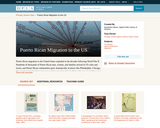
In this Wide Angle video, view a city area where illegal migrants from rural China live and work. [2:55]
- Subject:
- Social Studies
- Material Type:
- Audio/Video
- Lesson
- Provider:
- PBS LearningMedia
- Date Added:
- 11/06/2023

In this Wide Angle video, view a city area where illegal migrants from rural China live and work. [2:55]

Meet two sisters who have migrated from Poland to Ireland, one of three countries in the EU that welcomes immigrant workers from Eastern Europe, in this Wide Angle video.

This is a lesson designed by a biology teacher. In it, students use maps and evidence of island age, molecular genetics, morphology, and distance apart to determine how the islands came to be occupied by different species of lizards. It will take some time and requires extensive background knowledge.

This Nature video shows the migratory patterns and habits of the Rufous hummingbird. [2:41]

Migrant construction workers from rural China describe their living conditions in Beijing in this Wide Angle video segment.

Chinese migrant workers give insight into their status, lack of power and vulnerability in the new economic order in this video from Wide Angle.

This video segment from NOVA: "The Mystery of Animal Pathfinders" explores the migratorial exploits of monarch butterflies.

This extensive site chronicles the migration of people throughout history. The migration of people, objects, ideas, and cultures are explored and the impact of such moves discussed.

The most common mtDNA ancestor is an African woman named African "Eve" or Mitochondrial Eve. Good explanation of mtDNA versus nuclear DNA through visual interactive family tree.

Outstanding site that compliments an insect series on PBS. Interactive presentations include bee anatomy and honeybee hives. Includes interactive puzzles, teacher's guides, and formats for making insect masks.

The PBS video series "The Life of Birds" is accompanied with this site. There are articles about several aspects of birds and their behavior. This one chronicles the highest, fastest, and most extreme birds. There are lots of examples.

National Boarder Control Council President discusses his views and experiences at the U.S.-Mexican border. Text, audio, and video of this August, 2006, interview are available.

Decades of research has been dedicated to the impressive navigation skills of homing pigeons. To explain how these pigeons are able to find their way home from unfamiliar, distant sites, scientists have arrived at various theories. These include the ideas that pigeons have a "map sense" that helps them follow roads, a solar compass and/or an ability to detect and use the earth's magnetic field. In this video segment from Nature, learn how homing pigeons are used as couriers by business owner Dave Costlow. [2:34]

This site from Palomar College contains an interactive practice quiz containingfour questions on major concepts regarding gene flow. A great learning tool.

This collection uses primary sources to explore Puerto Rican migration to the US. Digital Public Library of America Primary Source Sets are designed to help students develop their critical thinking skills and draw diverse material from libraries, archives, and museums across the United States. Each set includes an overview, ten to fifteen primary sources, links to related resources, and a teaching guide. These sets were created and reviewed by the teachers on the DPLA's Education Advisory Committee.

Sure, maybe you saw Meep when you last visited the Museum, but did you know Red-tailed Hawks are migratory birds? Find out how our animal experts care for these fascinating migrators year-round at the Museum! Worksheets available for grades 1-5, 6-12, and all ages.

This resource provides information about communities that lived on or near water, including the canals.

This resource provides detailed information on the hummingbird, as well as several vivid photos and a video.

Students are introduced to the basic biology behind Pacific salmon migration and the many engineered Columbia River dam structures that aid in their passage through the river's hydroelectric dams. Students apply what they learn about the salmon life cycle as they think of devices and modifications that might be implemented at dams to aid in the natural cycle of fish migration, and as they make (hypothetical) Splash Engineering presentations about their proposed fish mitigation solutions for Birdseye River's dam in Thirsty County.

Eighty-two primary sources explore African American identity in the 20th century. They examine segregation, migrations, protest, community, and what remained to be overcome.